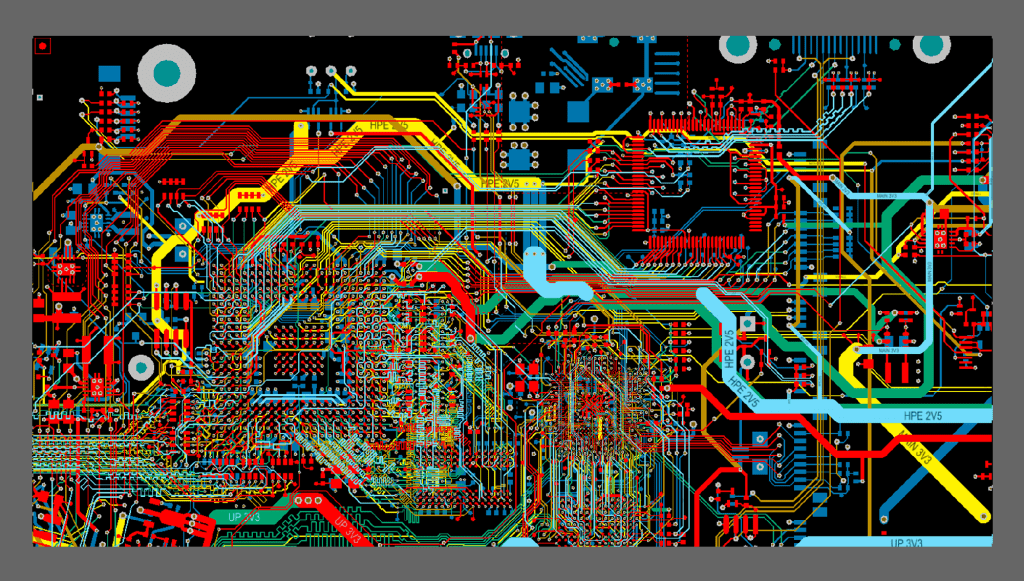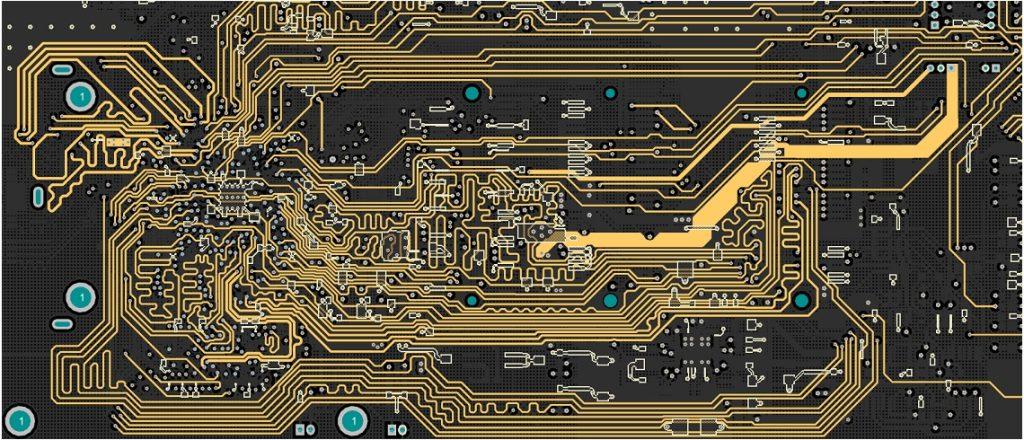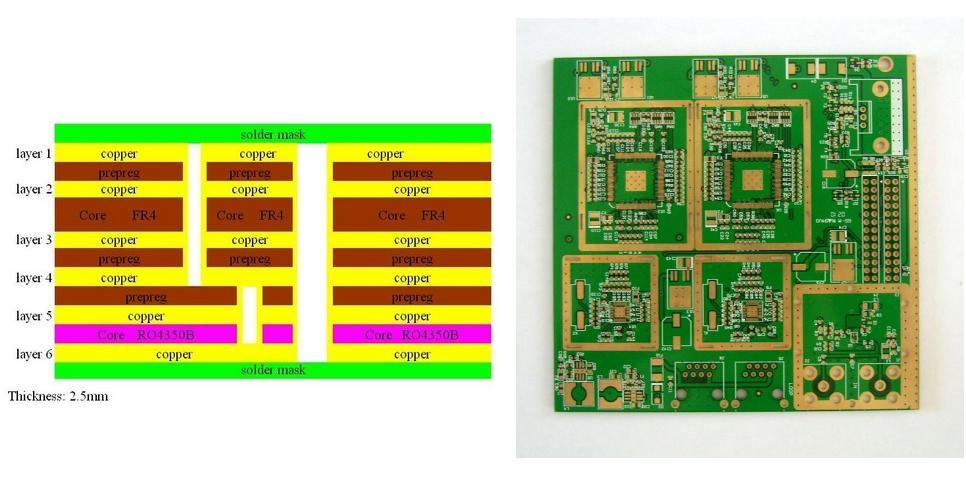PCB is also known as a printed circuit board, it can realize the line connection between electronic components and functional implementation, but also an important part of the power circuit design. The design process of a printed circuit board includes schematic design, electronic component database registration, design preparation, block division, electronic component configuration, configuration confirmation, wiring, and final inspection. During the process, no matter where in the process a problem is found, it must be returned to the previous process for re-confirmation or correction. This article is Anpllopcb’s summary of the latest PCB board design layout tips for 2022.
- Component layout basic rules
- Component wiring rules
- How to improve the anti-interference ability and electromagnetic compatibility?
- 3, to reduce noise and electromagnetic interference in some experiences.
- Contact Us
Component layout basic rules
1. layout by circuit module, to achieve the same function of the relevant circuit is called a module, the components in the circuit module should use the principle of proximity concentration, while digital and analog circuits are separated.
2. Positioning hole, standard hole and other non-installation holes around 1.27mm shall not be mounted elements, devices, screws, and other installation holes around 3.5mm (for M2.5), 4mm (for M3) shall not be mounted components.
3. the lying mounted resistor, inductor (plug-in), electrolytic capacitor, and other components below avoid cloth over a hole, avoid wave soldering after over hole and components shell short circuit.
4. The distance between the outer side of the components from the edge of the board is 5mm.
5. The distance between the outer side of the pad of the affixed components and the outer side of the adjacent cartridge components is greater than 2mm.
6. metal shell components and metal parts (shielding box, etc.) can not touch other components, can not be close to the printed line, or pad, and the spacing should be greater than 2mm. positioning holes, fastener installation holes, elliptical holes, and other square holes in the board from the outside of the board edge size greater than 3mm.
7. heat generating components can not be adjacent to the wire and thermal components; high heat devices to a balanced distribution.
8. power sockets should be arranged as far as possible around the printed board, power sockets and their connected bus bar terminals should be arranged on the same side. Special attention should be paid not to power sockets and other welding connectors arranged between the connectors, to facilitate the welding of these sockets, connectors, and power cable design and tying. Power sockets and welding connector layout spacing should be considered to facilitate the plugging and unplugging of the power supply.
9. The arrangement of other components: all IC components are aligned unilaterally, with polar components’ polarity marked clearly, polarity marking on the same printed board shall not be more than two directions, and when two directions appear, the two directions are perpendicular to each other.
10, the board wiring should be sparse and dense, when the sparse difference is too large should be filled with mesh copper foil, and the grid is greater than 8mil (or 0.2mm).
11, SMD pads can not have through holes, so as not to lose solder paste caused by component solder. Important signal lines are not allowed to pass between the feet from the socket.
12, SMD single-sided alignment, character direction consistent, consistent package direction.
13, the polarity of the device in the same board polarity marking direction as far as possible to maintain consistency.

Component wiring rules
1, drawing wiring area from the edge of the PCB board ≤ 1mm in the area, as well as within 1mm around the mounting holes, wiring is prohibited.
2, power lines as wide as possible, should not be less than 18mil; signal line width should not be less than 12mil; CPU into and out of the line should not be less than 10mil (or 8mil); line spacing of not less than 10mil.
3, the normal over-hole should not be less than 30mil.
4、Double row inline plug: pad 60mil, aperture 40mil.
(1) 1/4W resistor: 51*55mil (0805 surface mount); 62mil pad and 42mil aperture when inserted directly.
(2) Non-polarized capacitor: 51*55mil (0805 surface mount); 50mil pad, 28mil aperture when plugged directly.
5, pay attention to the power line and the ground should be as radial as possible, as well as the signal line can not appear back to the loop alignment.
How to improve the anti-interference ability and electromagnetic compatibility?
In the development of electronic products with processors, how to improve the anti-interference ability and electromagnetic compatibility?
1, some of the following systems pay special attention to anti-electromagnetic interference.
(1) The microcontroller clock frequency is particularly high, and the bus cycle is a particularly fast system.
(2) Systems containing high-power, high-current drive circuits, such as spark-generating relays, high-current switches, etc.
(3) Systems containing weak analog signal circuits and high-precision A/D converter circuits.
2, to increase the system’s anti-electromagnetic interference ability take the following measures.
(1) Selection of microcontrollers with low frequency.
The selection of microcontrollers with low external clock frequency can effectively reduce noise and improve the system’s immunity to interference. With the same frequency of the square wave and sine wave, the square wave in the high-frequency components than the sine wave much more.
Although the amplitude of the wave of the high-frequency components of the square wave, is smaller than the fundamental wave, the higher the frequency the more likely to be emitted as a source of noise, the microcontroller generated by the influential high-frequency noise is about three times the frequency of the clock.
(2) reduce the distortion in signal transmission
Microcontrollers are mainly manufactured using high-speed CMOS technology. The quiescent input current at the signal input is about 1mA, the input capacitance is about 10PF, the input impedance is quite high, and the outputs of the high-speed CMOS circuits have considerable carrying capacity, i.e., considerable output values, and the output of a gate is led through a very long line to the input impedance is quite high, the reflection problem is serious, and it causes signal distortion and increases system noise. When Tpd>Tr, it becomes a transmission line problem, and signal reflection, impedance matching, etc. must be considered.
The delay time of the signal on the printed board is related to the characteristic impedance of the leads, i.e., to the dielectric constant of the printed circuit board material. It can be roughly considered that the speed of signal transmission in the printed board leads, to about 1/3 to 1/2 of the speed of light between. The Tr (standard delay time) of the common logic phone components in systems composed of microcontrollers is between 3 and 18 ns.
On a printed circuit board, the signal passes through a 7W resistor and a 25cm long section of lead with a delay time on the line of roughly between 4 and 20ns. In other words, the shorter the signal lead on the printed circuit, the better, not more than 25cm long, and the number of vias should also be as small as possible, no more than two.
When the rise time of the signal is faster than the signal delay time, it should be processed by fast electronics. At this time consider the transmission line impedance matching, for a printed circuit board between the integrated blocks of signal transmission, to avoid the situation Td “Trd, the larger the printed circuit board the system speed can not be too fast.
With the following conclusion to summarize the printed circuit board design a rule: the signal transmission on the printed board, the delay time should not be greater than the nominal delay time of the devices used.
(3) Reducing cross-talk between signal lines.
A step signal with a rise time of Tr at point A travels through lead AB to end B. The delay time of the signal on lead AB is Td. At point D, a page pulse signal with width Tr is induced after Td time due to the forward transmission of the signal at point A, the reflection of the signal upon arrival at point B, and the delay of the AB line. At point C, due to the transmission and reflection of the signal on AB, a positive pulse signal with a width of twice the delay time of the signal on the AB line, i.e., 2Td, is induced. This is the cross-talk between signals.
The strength of the interfering signal is related to the di/at of the signal at point C, and the distance between the lines. When the two signal lines are not very long, what is seen on AB is an iteration of two pulses.
CMOS process manufacturing micro-control by the high input impedance, high noise, noise tolerance is also very high, the digital circuit is iterative 100 ~ 200mv noise and does not affect its work. If the AB line in the figure is an analog signal, this interference becomes intolerable. If the printed circuit board is a four-layer board, one of which is a large area of the ground, or double panel, the reverse side of the signal line is a large area of the ground, and the cross-talk between the signals will become smaller.
The reason is that the large area of the ground reduces the characteristic impedance of the signal line, and the reflection of the signal at the D side is greatly reduced. The characteristic impedance is inversely proportional to the square of the dielectric constant of the medium between the signal line and the ground and is proportional to the natural logarithm of the medium thickness.
If the AB line is for an analog signal, to avoid interference from the digital circuit signal line CD to AB, the AB line below to have a large area of ground, AB line to CD line distance to be greater than the distance between AB line and ground 2 ~ 3 times. Available local shield ground, in the side of the lead with a lead junction on the left and right side of the cloth to ground.
(4) Reduce the noise from the power supply
The power supply in the system to provide energy at the same time will also add noise to the power supply. The reset line, interrupt line, and some other control lines of the microcontroller in the circuit are susceptible to interference from external noise.
Strong interference from the power grid enters the circuit through the power supply, and even in a battery-powered system, the battery itself has high-frequency noise. Analog circuits in the analog signal more withstand interference from the power supply.
(5) Pay attention to the high-frequency characteristics of the printed circuit board and components
In the case of high frequency, the printed circuit board leads, vias, resistors, capacitors, and connectors, such as distributed inductance and capacitance can not be ignored. The distributed inductance of the capacitor cannot be ignored, and the distributed capacitance of the inductor cannot be ignored.
The resistance produces the reflection of the high-frequency signal, the distributed capacitance of the lead will play a role when the length is greater than 1/20 of the corresponding wavelength of the noise frequency, it produces the antenna effect, and the noise is emitted outward through the lead.
The over-hole of a printed circuit board causes a capacitance of approximately 0.6pf. The packaging material of an integrated circuit itself introduces 2 to 6pf capacitance. A connector on a circuit board has a 520nH distributed inductance. A 24-pin IC cutout in a double-row straight cutout introduces a distributed inductance of 4 to 18nH.
These small distribution parameters for this line of lower-frequency microcontroller systems are negligible, and high-speed systems must be given special attention.
(6) Component arrangement to reasonable partition
Components in the printed circuit board arrangement of the location to fully consider the issue of anti-electromagnetic interference, one of the principles is for the lead between the components to be as short as possible. In the layout, the analog signal part, the high-speed digital circuit part, and the noise source part (such as relays, high-current switches, etc.) These three parts are reasonably separated so that the signal coupling between each other is.
Deal with the ground wire: printed circuit board, power lines, and ground important. Overcome electromagnetic interference, the main means of grounding.
For the double panel, the ground arrangement is particularly delicate, by using the single-point grounding method, power, and ground from the two ends of the power supply to the printed circuit board up, power contact, and ground contact. Printed circuit board, to have more than one return ground, these will be gathered back to the power of that contact, is the so-called single point of grounding.
The so-called analog ground, digital ground, and high-power device ground open division mean that the wiring is separated, and all converge to this ground point. When connected to signals other than printed circuit boards, shielded cables are usually used. For high-frequency and digital signals, the shielded cable is grounded at both ends. For low-frequency analog signals, one end of the shielded cable is grounded for good.
Circuits that are very sensitive to noise and interference or circuits where high-frequency noise is particularly serious should be shielded with a metal cover.
(7) Use good decoupling capacitors
A good high-frequency decoupling capacitor can remove high-frequency components as high as 1GHZ. Ceramic chip capacitors or multilayer ceramic capacitors have better high-frequency characteristics. When designing a printed circuit board, a decoupling capacitor should be added between the power and ground of each integrated circuit.
The decoupling capacitor has two roles: on the one hand, it is the storage capacitor of this IC, providing and absorbing the charging and discharging energy at the moment the IC opens and closes the door; on the other hand, it bypasses the high-frequency noise of the device.
The typical decoupling capacitor in digital circuits is a 0.1uf decoupling capacitor with 5nH distributed inductance, which has a parallel resonance frequency of about 7MHz, that is to say, it has a good decoupling effect for noise below 10MHz, and almost no effect on noise above 40MHz.
The 1uf, 10uf capacitor, with parallel resonance frequency above 20MHz, is better for removing high-frequency noise. Where the power enters the printed board and a 1uf or 10uf decoupling capacitor is often advantageous, even for battery-powered systems this capacitor is needed.
For every 10 pieces or so of the integrated circuit add a piece of charge and discharge capacitors, or called storage capacitors, with capacitor size optional 10 uf. do not use electrolytic capacitors, electrolytic capacitors are two layers of pry film rolled up, this rolled-up structure in the high-frequency performance of inductance, the use of bile capacitors or polycarbonate brewing capacitors.
The selection of decoupling capacitor value is not strict, it can be calculated by C=1/f; that is, 10MHz takes 0.1uf, and for the system composed of a micro-controller, take 0.1~0.01uf can be between.

3, to reduce noise and electromagnetic interference in some experiences.
(1) can use low-speed chips without high-speed, high-speed chips used in key places.
(2) can string a resistor approach to reduce the rate of control circuit jumps along the upper and lower edges.
(3) Try to provide some form of damping for relays, etc.
(4) Use a frequency clock that meets the system requirements.
(5) The clock generator is as *close as possible to the device that uses that clock. Ground the quartz crystal oscillator case.
(6) Circle the clock area with a ground wire and keep the clock wire as short as possible.
(7) I/O driver circuitry should be as *close to the printed board edge as possible to get it off the printed board as soon as possible. The signal entering the printed board should be filtered, and the signal coming from the high-noise area should also be filtered while using a series termination resistor to reduce the signal reflection.
(8) MCD useless terminal to connect high, or ground, or defined as an output, the integrated circuit should be connected to the end of the power ground, do not dangle.
(9) Do not overhang the idle gate circuit input, idle op-amp positive input ground, or negative input to the output.
(10) Printed boards try to use 45-fold lines instead of 90-fold lines wiring to reduce the external emission and coupling of high-frequency signals.
(11) Printed board by frequency and current switching characteristics partition, noise components, and non-noise components to be farther away from some.
(12) single panel and double panel with a single point of connection power and single point of grounding, power lines, ground as thick as possible, the economy can afford to use the multi-layer board to reduce the power supply, ground capacitive inductance.
(13) clock, bus, and chip select signals to be away from the I/O lines and connectors.
(14) Analog voltage input lines and reference voltage terminals should be as far away as possible from the digital circuit signal lines, especially the clock.
(15) For A/D class devices, the digital part and the analog part should be unified rather than cross *.
(16) clock line perpendicular to the I/O line than parallel I/O line interference is small, the clock component pins away from the I/O cable.
(17) Component pins as short as possible, decoupling capacitor pins as short as possible.
(18) The key lines should be as thick as possible and with protective grounds on both sides. High-speed lines should be short and straight.
(19) Do not parallel the noise-sensitive lines with the high current, high-speed switch lines.
(20) Do not run lines under quartz crystals and noise-sensitive devices.
(21) Weak signal circuits, low-frequency circuits around do not form current loops.
(22) Any signal does not form a loop, such as unavoidable so that the loop area is as small as possible.
(23) Each IC is a decoupling capacitor. Add a small high-frequency bypass capacitor to the side of each electrolytic capacitor.
(24) Use high-capacity tantalum capacitors or poly cool capacitors instead of electrolytic capacitors for circuit charge and discharge storage capacitors. When using tubular capacitors, the case should be grounded.
Contact Us
Are you looking for help with your next PCB design? Contact us today to learn more about our capabilities or to consult with one of our engineering experts about your next project.



